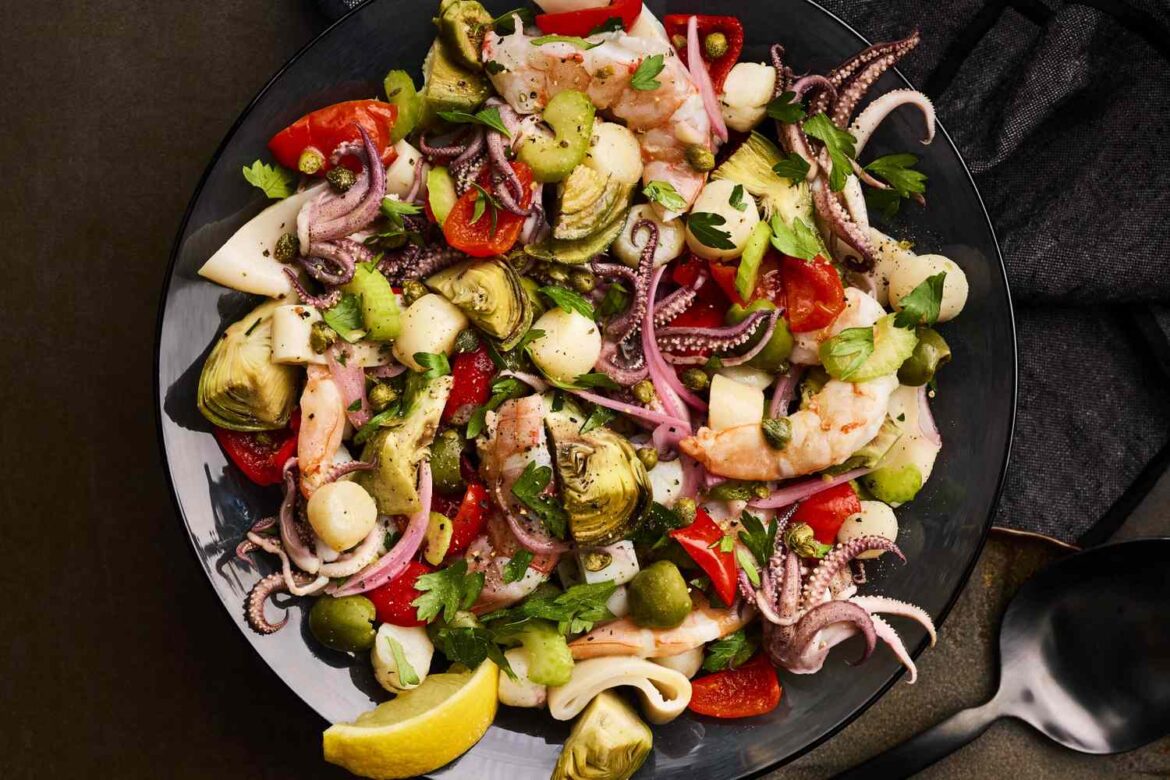Poaching the seafood in a quick shrimp-shell stock delivers deeply flavored shrimp, squid, and scallops.Shocking the seafood in an ice bath prevents it from overcooking and keeps it tender and juicy.A zippy red wine vinaigrette brightens and balances the natural sweetness of the seafood.
Insalata di Frutti di Mare — which translates to “fruits of the sea salad” — is an Italian classic built on gently cooked seafood tossed in a zesty vinaigrette. It can be both celebratory and practical served as a centerpiece for the Feast of the Seven Fishes on Christmas Eve or a cooling antipasto served during the warmer months in summer. While a number of different seafood varieties can be used, this version features shrimp, squid, and bay scallops, which are briefly poached in an aromatic stock made from sautéed shrimp shells, parsley, peppercorns, garlic, and dry white wine. Next, the seafood is tossed with traditional antipasto vegetables like crisp celery, marinated artichoke hearts, roasted red peppers, and buttery Castelvetrano olives. Everything is finally tossed with a simple red wine vinegar vinaigrette.
The chill time in this recipe is what marries the flavors and keeps everything fresh and balanced. It’s all about highlighting the quality of the seafood and not masking it with a heavy dressing or ingredients that will overpower the seafood’s clean flavors.
At first glance, this recipe might look complicated, but it only requires a few easy, fundamental cooking techniques. Poaching the seafood just until opaque protects its delicate nature. Shocking the seafood in an ice bath afterward prevents it from overcooking and helps it retain a tender texture without turning rubbery. The salad holds well, making it ideal for any kind of entertaining. Whether you’re cooking for a crowd or prepping ahead for an easy weekend lunch, this chilled salad delivers brightness, salinity, and a taste of the Mediterranean in every bite.
Can you marinate seafood in the vinaigrette for too long?
Marinating the salad in the vinaigrette marries the flavors and makes the salad deeply complex and flavorful. However, the high-acid content in the vinaigrette can also toughen the seafood through a process called denaturation, which will turn the texture chalky over time. Aim for 1 to 3 hours in the refrigerator; after 6 to 8 hours, you might find the seafood is less springy. You can still make this salad in advance, but we would recommend a maximum of 12 hours for the best results.
The best way to poach seafood
Poaching seafood starts with a similar method to poaching any other ingredient. Begin by building a flavorful base for your poaching liquid. In this recipe, the shrimp shells are briefly sautéed with garlic before the water is added to give them more flavor. Dry white wine, peppercorns, and parsley infuse the broth that will permeate the seafood. It’s important to monitor the heat and keep the liquid at a bare simmer: You don’t want to boil your seafood. If using different types of seafood, make sure to poach in batches based on type, as the different ingredients will require different cooking times, and some parcook faster than others.
Notes from the Food & Wine Test Kitchen
Save the poaching liquid and use it to flavor soup, risotto, or pasta sauce.To replace jarred roasted red bell peppers, char a fresh red bell pepper over a gas flame. Steam in a covered heatproof bowl for 10 to 15 minutes, then peel with a paring knife or paper towel.Swap in other seafood like mussels, clams, or octopus, adjusting cooking times so each is just cooked through.
Suggested pairing
A coastal Italian white: 2024 Marisa Cuomo Furore Bianco Costa d’Amalfi: Marisa Cuomo’s 2024 Furore Bianco (Falanghina-Biancolella) is tailor-made for this salad. Its brisk acidity and mineral, sea-spray edge cut the tangy vinegar marinade and refresh bites of shrimp, squid, and scallops. Citrus and herbal notes echo celery, parsley, and roasted peppers, while a faint almond savor marries artichokes and Castelvetrano olives. Grown on Amalfi’s cliffside terraces, it stays light, clean, saline, and balanced, keeping briny capers vivid without bitterness and letting the seafood’s sweetness shine.
This recipe was developed by Craig Ruff; the text was written by Andee Gosnell.


Dining and Cooking